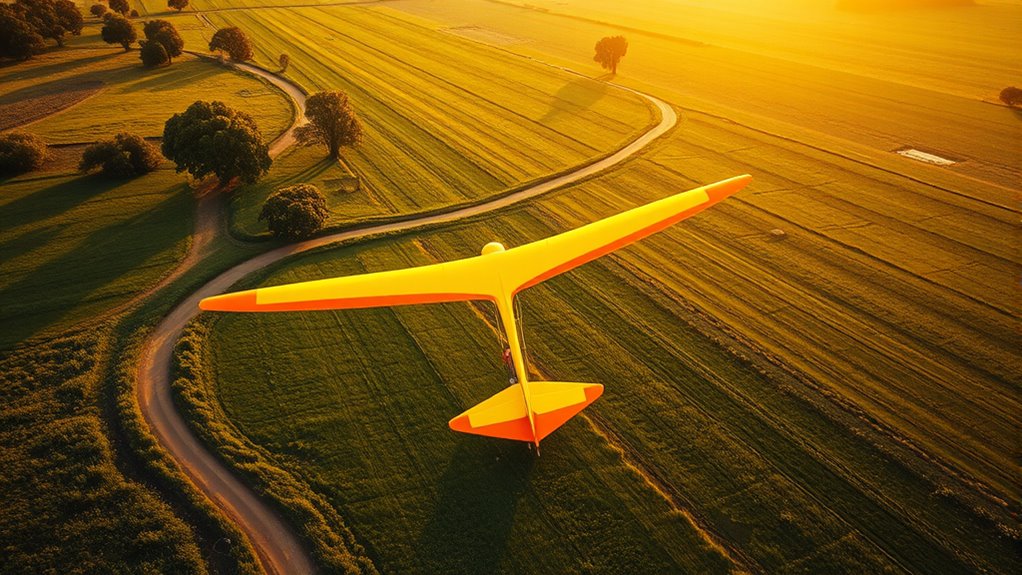When choosing a field to land, look for open, flat areas free of obstacles like trees, power lines, or fences. Quickly assess the terrain during your descent to spot hazards and identify safe spots. Use gentle steering and controlled flares to slow your descent while avoiding obstacles. Keep your body ready for impact and aim for a smooth, controlled landing. Want tips on mastering obstacle avoidance and landing techniques? Keep exploring to stay safe every time.
Key Takeaways
- Select open, flat, obstacle-free fields with clear, level terrain for safe landings.
- Conduct a quick terrain assessment during descent to identify potential hazards early.
- Use gentle steering and trajectory adjustments to avoid obstacles like power lines and trees.
- Keep feet slightly bent and prepare for a parachute landing fall to minimize impact injuries.
- Practice controlled approaches and obstacle avoidance techniques regularly for safer landings.

Landing out safely requires careful preparation and quick thinking. When you find yourself needing to land in an unfamiliar area, your primary focus should be on selecting a suitable field and executing proper parachute landing techniques. Your ability to quickly assess the terrain, identify potential hazards, and adapt your approach can make the difference between a safe landing and an injury. Start by scanning the landscape as you descend, looking for open, flat fields free from obstacles like power lines, trees, or fences. A clear, level area gives you the best chance to land smoothly and control your momentum. When approaching, keep in mind that obstacle avoidance strategies are vital; you need to be ready to adjust your trajectory if you notice hazards nearby.
As you near the ground, deploy your parachute landing techniques that emphasize proper body positioning. Keep your feet and knees slightly bent, and aim to land with your feet together and your body upright. This stance helps absorb the impact, reducing the risk of injury. If you spot an obstacle such as a tree or power line in your landing zone, don’t panic. Instead, use obstacle avoidance strategies—like steering your parachute away from hazards by gently steering the controls or adjusting your descent angle. Always maintain situational awareness; small movements can considerably alter your landing path.
If you’re approaching a field cluttered with obstacles, consider executing a controlled turn or flare to slow your descent and position yourself for a safer landing spot. Flare your parachute smoothly to decrease your vertical speed while maintaining control. If you notice that the ground is too uneven or filled with hazards, prepare for a parachute landing fall (PLF). This technique involves rolling on impact, helping distribute the force across your body and minimizing injury. Being familiar with parachute landing techniques and practicing them regularly can significantly improve your safety during landings.
Frequently Asked Questions
How Do Weather Conditions Affect Landing Safety?
Weather conditions considerably impact your landing safety through meteorological impacts like wind, rain, and fog. Sudden weather pattern changes can reduce visibility and cause turbulence, making it harder to control your aircraft. Staying aware of current weather reports and understanding meteorological impacts helps you anticipate challenges. By monitoring weather pattern awareness, you can choose safer fields, avoid hazards, and ensure a smoother, safer landing even in changing conditions.
What Emergency Procedures Should I Memorize Before Landing?
You should memorize your pre-landing checklist and emergency communication procedures. Before landing, review critical steps like securing the aircraft and selecting a suitable field. If an emergency arises, quickly communicate your situation to air traffic control or nearby pilots, using clear, concise language. Staying calm, following your checklist, and maintaining effective communication guarantee you handle the emergency safely and efficiently.
How Can I Identify Hidden Obstacles During Descent?
Imagine you’re a hawk scanning the ground below. To spot hidden obstacles during descent, sharpen your obstacle detection skills and rely on terrain awareness tools. Keep a keen eye on your instruments, look for subtle changes in terrain, and listen for ground proximity alarms. Use your peripheral vision to identify potential hazards lurking beneath the surface. Staying alert guarantees you avoid surprises and land safely, even with unseen obstacles.
What Equipment Is Essential for Safe Landing in Unexpected Terrain?
You need essential equipment like a well-maintained parachute, a reliable altimeter, and a sturdy helmet for safe landings on unexpected terrain. Make certain your gear is regularly inspected and maintained to guarantee peak performance. Practice effective landing techniques suited for rough or unfamiliar surfaces, such as controlled parachute landings. These preparations help you adapt quickly, minimize injury risks, and ensure a safe touchdown even in challenging environments.
How Do Wind Shifts Influence Landing Field Selection?
Wind shifts can markedly impact your landing zone selection. You should look for signs of wind drift, like bent or leaning trees, to gauge the wind’s direction and strength. Always prioritize landing in areas with clear, visible landing zone markings, ensuring a safe and controlled descent. Adjust your approach based on wind conditions, aiming for a spot that offers the least risk of obstacles and stable airflow for a safe landing.
Conclusion
Just like Icarus learned when flying too close to the sun, knowing your landing options and spotting obstacles can prevent a crash. Stay alert, choose your fields wisely, and keep your eyes open for hazards. With careful planning and quick thinking, you can navigate your landing safely, turning a potential disaster into a triumphant touchdown. Remember, the key to a safe landing is your preparedness—so trust your instincts and land with confidence.
With a heart that soars as high as the skies, Aria, affectionately known as “Skylark,” is the driving force behind Soaring Skyways. Her journey into the gliding world began as a young dreamer gazing up at the soaring birds, yearning to experience the weightlessness and freedom they embodied. With years of experience both in the cockpit and behind the scenes, Aria’s commitment to the gliding community is unwavering.










